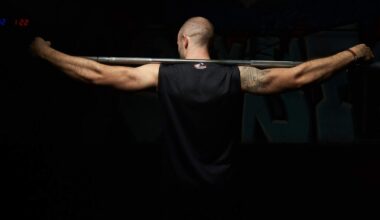Active Recovery Methods for Triathlon Training Days
Active recovery methods are essential for triathletes looking to accelerate healing and enhance performance. These techniques help promote blood circulation, restore muscles, and prevent soreness after intense training. Instead of complete rest, active recovery involves low-intensity activities that keep the body moving. This can include activities such as walking, light cycling, or swimming at a gentle pace. These exercises allow your heart rate to stay elevated, which in turn helps flush out lactic acid and other metabolites from your system. Furthermore, engaging in active recovery can also improve flexibility and maintain joint range of motion. Triathletes often experience muscle stiffness, and active recovery combats that by facilitating better blood flow. Additional benefits include reducing fatigue and preventing burnout, ensuring that training stays on track. While some may prefer lounging on recovery days, it’s crucial to understand that staying active can significantly contribute to overall athletic performance. Incorporating active recovery into your routine helps you prepare for more challenging training sessions ahead and supports long-term athletic success. A well-structured recovery plan leads to more efficient workouts, keeping athletes in the competitive arena much longer.
Various techniques exist within the realm of active recovery that aim to target different muscle groups effectively. Stretching exercises, for example, are an integral part of recovery routines since they enhance flexibility and aid muscle recovery. The use of foam rollers or massage balls can offer deeper relaxation and relieve muscle tension. These tools are beneficial for self-myofascial release, which decreases muscle stiffness and improves mobility. Swimming is another wonderful recovery option, allowing for movement without putting stress on the joints. The buoyancy of water supports the body while alleviating pressure, making swimming an ideal low-impact exercise. Additionally, yoga and tai chi can promote relaxation while improving balance and core strength. Engaging in these practices not only aids in recovery but also contributes to mental well-being. Every triathlete must find what forms of active recovery work best for their body. Taking the time to experiment and listen to your body’s feedback is valuable. Never underestimate the importance of recovery days; they prepare the body for the next training block while reducing the risk of injury. Therefore, adopt a balanced and enjoyable approach to active recovery for optimal training outcomes.
The Role of Nutrition in Recovery
Complementing active recovery with proper nutrition can magnify its benefits significantly. Nutrition plays a pivotal role in repairing muscles and replenishing energy stores post-training. Consuming a combination of carbohydrates and protein post-exercise enhances muscle recovery while restoring glycogen levels. Some optimal recovery choices include smoothies packed with fruits and protein powder, or whole foods like chicken, quinoa, and vegetables. Staying hydrated is equally crucial; water helps transport nutrients throughout the body and offsets fluid loss during workouts. Electrolyte drinks can also assist in replenishing essential minerals lost through sweat. It’s vital for triathletes to prioritize nutrition not only on training days but also during recovery. Incorporating anti-inflammatory foods such as berries, leafy greens, and nuts can further aid in reducing muscle soreness. Foods rich in omega-3 fatty acids, like salmon and flaxseeds, also contribute beneficially. Crafting a nutrition plan tailored to your workouts and recovery needs will enhance your overall training program. Ultimately, understanding the intimate link between nutrition and recovery enables triathletes to make informed choices that streamline their training processes and support better performance.
Restorative sleep is another essential component of recovery that should not be overlooked. Sleep facilitates the body’s natural repair processes and is crucial for physical and mental restoration. During sleep, the body works hard to rebuild muscle tissues and release growth hormones. Triathletes should aim for seven to nine hours of quality sleep each night to maximize recovery benefits. Establishing a restful sleep environment, free of distractions, can help improve sleep quality. Techniques such as avoiding screens before bed and maintaining a consistent sleep schedule may promote better rest. Additionally, strategic napping can offer an extra boost during the day, especially after intense training sessions. Short naps, ideally lasting around 20-30 minutes, can help alleviate fatigue, enhance mood, and improve focus. Balancing training with adequate sleep ensures athletes are recharged for each workout, ultimately leading to improved performance. It’s also important to listen to your body and rest when necessary, as ignoring fatigue can increase injury risk. Therefore, prioritizing sleep is integral to any successful recovery strategy for triathletes aiming for peak performance.
Incorporating Active Recovery into Training Schedules
Incorporating active recovery into triathlon training schedules requires careful planning to optimize performance. Triathletes can designate specific days for active recovery or tailor them based on training intensity. Following a high-intensity training day, athletes may benefit from a lighter training session focused on active recovery. This strategically places recovery to follow intense physical demands, allowing structures to rebuild and energy levels to restore. Additionally, balancing training loads is essential; alternating between hard and easy days can help manage fatigue while maximizing adaptations. Triathletes should also listen to their bodies; if feelings of excessive fatigue arise, it may be a sign to prioritize a recovery day. Engaging family or friends in active recovery sessions can encourage bonding and facilitate accountability. With the right mindset and support, triathletes can make the most out of recovery days, enhancing their enjoyment and dedication to training. Moreover, tracking recovery progress and fatigue levels through a training journal can help athletes make informed decisions. Ultimately, designing an individualized training program that emphasizes recovery contributes to long-term success in the triathlon journey.
Triathletes should also leverage technology to monitor their recovery effectively. Wearable devices and apps can provide valuable data, such as heart rate variability and sleep patterns, which indicate recovery status. Tracking these metrics allows athletes to assess their readiness for rigorous training sessions. Moreover, some applications provide insights into fatigue levels, helping to dictate when to push harder and when to ease up. Combining technology with traditional methods may offer a comprehensive picture of recovery. This technology-driven approach enables triathletes to adapt their training programs, ensuring they align with physical and mental states. It’s essential to establish a baseline for personal metrics to evaluate improvements over time. Additionally, athletes should engage in regular self-assessment practices; reflecting on how both body and mind feel post-activity enhances overall awareness. Acknowledging stressors, energy levels, and overall mood can influence recovery choices. Investing time in learning about recovery tools, technologies, and self-reports can significantly enhance triathlete performance. As recovery methods evolve, incorporating these tools aids athletes in staying ahead, optimizing training plans, and fostering lasting fitness.
Final Thoughts on Active Recovery Techniques
In conclusion, active recovery is a critical element in a triathlete’s training routine, providing substantial benefits for athletic performance. By exploring various active recovery techniques, athletes can find methods that resonate with their needs. Emphasizing gentle activities, appropriate nutrition, restorative sleep, and the incorporation of technology into training can enhance recovery. Furthermore, understanding the importance of recovery ensures athletes remain engaged and ready to tackle further challenges. Triathletes should seek a balanced approach, allowing their bodies to recuperate while maintaining a connection to their training. The journey of preparation is long, and recovery must be treated as a priority rather than an afterthought. Learning to embrace recovery days fosters resilience and aids in the prevention of burnout or injuries. It’s clear that promoting wellness and recovery is foundational for achieving competitive goals. By blending various recovery strategies, triathletes can pave the way for sustained improvement, enhancing performance and personal fitness journeys. Ultimately, adopting active recovery as a mainstay ensures that the spirit of competition continues to thrive. Each successful recovery paves the way for better results on race day and beyond!
Overall, integrating a thoughtful active recovery plan into triathlon training enhances both physical and mental health. Athletes can improve their performance by utilizing various low-intensity techniques while listening to their bodies. These recovery methods cultivate resilience and build a foundation for continued success. Adopting a proactive approach to recovery reaffirms each triathlete’s commitment to their training while acknowledging that rest is as important as hard work. Striking this balance is vital to thrive in a sport as demanding as triathlon. The right combination of movement, nutrition, and rest combined with technology can lead to optimal recovery. Engaging with fellow triathletes or coaches to discuss recovery ensures that one stays accountable and supported. Emphasizing active recovery as part of the overall training strategy may lead to more rewarding and enjoyable experiences. Ultimately, a healthy athlete is a successful athlete. So take those active recovery days seriously, and reap the fruits of your dedication and hard work!


